#Cloud Infrastructure
Explore tagged Tumblr posts
Text
CEOs a few years ago all over the planet:
"Let's move all critical infrastructure software to the cloud. What could possibly go wrong?"
Same time in the Microsoft / Google/ Amazon HQ meetings (executive board plus legal department plus chief cloud administrator):
Admin (very agitated): "There's no effing way we'll be able to guarantee uptime and redundancy 24/7!"
Lawyer (very agitated): "The lawsuits will cost billions and the possible casualty in human life cannot even be measured in good consciousness."
CEO (dead ass calm, demonic soothing voice): "Chill. The contracts will be waterproof in our favor and the tax payers will cover...Once it all hovers in our clouds, there's no going back!"
*most evil cackling imaginable*

45K notes
·
View notes
Text
In today’s data-driven world, the demand for high-performance computing (HPC) continues to rise. Whether you're running simulations, training AI models, or performing intensive data analysis, your infrastructure needs to be fast, flexible, and financially sustainable. At Sharon AI, we deliver high-performance, scalable, and cost-effective HPC cloud infrastructure tailored to meet modern compute needs. Why Choose Sharon AI for HPC Cloud Infrastructure?
High Performance: Our cloud infrastructure is built on cutting-edge GPUs and CPUs, ensuring maximum compute power and throughput for the most demanding workloads.
Scalability: Instantly scale your compute resources up or down, without the constraints of on-prem systems. Whether you're running a single job or managing large-scale workloads, our scalable cloud infrastructure adapts to your needs.
Cost Efficiency: Achieve cost savings with a cost-effective HPC infrastructure that eliminates the need for upfront capital expenditures. Pay only for what you use, when you use it.
Ideal for AI, Engineering, and Scientific Workloads Sharon AI's HPC solutions are optimized for AI training, deep learning, genomics, fluid dynamics, financial modeling, and more. With seamless integration and rapid provisioning, your team can focus on innovation, not infrastructure. Looking to accelerate your workloads without breaking your budget? Discover how our HPC cloud infrastructure can drive performance and flexibility for your business. 👉 Explore our HPC solutions
0 notes
Text
Smart Infrastructure for Cloud Communications with Next-Gen Data-Center Frameworks
As digital transformation accelerates across industries, the demand for faster, more reliable, and scalable communication infrastructures has never been higher. Cloud Communications with Next-Gen Data-Center technologies are emerging as the cornerstone for businesses seeking to optimize performance, ensure data security, and future-proof their operations in a hyperconnected world.
Introduction to Modern Cloud Communications
Cloud communications have evolved into a critical enterprise resource, enabling remote collaboration, centralized control, and real-time data access. Businesses now operate in a distributed manner, relying heavily on cloud-based platforms for voice, video, messaging, and data services. This transition requires a robust, low-latency network infrastructure that traditional data centers often struggle to provide.
The Evolution of Data-Center Network Technologies
Next-generation data-center networks are built for high efficiency, scalability, and automation. These infrastructures use technologies such as SDN, NFV, edge computing, and AI-based monitoring to dynamically manage workloads and traffic. Their architecture supports horizontal scalability and multi-cloud deployments, making them ideal for today’s data-intensive and real-time cloud communications.
How Next-Gen Infrastructure Empowers Cloud Communications
Cloud Communications with Next-Gen Data-Center solutions significantly enhance the performance and reliability of enterprise communication tools. These networks reduce latency, offer higher bandwidth, and ensure service continuity even during peak demand. Integration with 5G and IoT networks also enhances device-to-cloud interaction, which is essential for modern enterprises operating across diverse geographies.
Key Benefits of Integrated Cloud and Data-Center Systems
The integration of cloud communications with next-gen data centers brings increased speed, agility, and security. Companies can scale their communication systems as needed without investing in extensive physical infrastructure. Enhanced data routing, proactive threat detection, and seamless failover capabilities ensure optimal uptime and data integrity, which is crucial for mission-critical applications.
Challenges and Considerations for Deployment
Despite the advantages, implementing next-gen data-center solutions for cloud communications comes with challenges. These include managing the complexity of hybrid environments, ensuring regulatory compliance, and the need for skilled IT personnel. Choosing the right partners and adopting standardized frameworks can mitigate many of these risks and enable a smoother transition.
Future Outlook for Cloud Communications with Next-Gen Data-Centers
As AI, machine learning, and edge computing become more pervasive, the synergy between cloud communications and next-gen data centers will deepen. Enterprises will benefit from predictive analytics, automated network management, and adaptive QoS, leading to unprecedented efficiency and innovation. The future is geared towards intelligent, self-optimizing networks that empower communication infrastructures to adapt and scale on demand.
For more info :
Conclusion
Cloud Communications with Next-Gen Data-Center technologies are reshaping the digital backbone of enterprises. By adopting these advanced infrastructures, businesses can unlock improved agility, better security, and enhanced operational continuity. The shift is not just about upgrading hardware but about embracing a more resilient, intelligent, and future-ready communication model.
#bi-journal news#bi-journal services#business insight journal#Cloud Communications#Next-Gen Data-Center#Enterprise Connectivity#Data Center#Innovation#Hybrid Cloud Solutions#Cloud Infrastructure
0 notes
Text

Are you looking for Cloud Partner who can assist you with Cloud migration, infrastructure Monitoring, Cloud Cost Optimisation and architecture design?
At techjour, an advanced Cloud Partner, we provide these benefits at no additional csot - ensuring you maximise the value of your Cloud investment.
Lets discuss, how you can leverage these advantage by partnering with us.
#technology#startup#automation#trendingnow#cloud service provider#cloudcomputing#cloud services#google cloud#aws cloud#microsoft azure#cloudmigration#cloud mining#cloud infrastructure#usa news#technology news
0 notes
Text
How Colocation Cloud Supports Hybrid and Multi-Cloud Strategies
Cloud services have become an integral part of modern digital transformation initiatives, enabling enterprises to scale, innovate, and operate more efficiently. However, the cloud landscape is rapidly evolving, with a noticeable shift toward hybrid and multi-cloud strategies. Organizations are increasingly seeking the flexibility, scalability, and cost-efficiency offered by a hybrid mix of private and public cloud infrastructures.
According to Gartner, nearly 90% of organizations will adopt hybrid cloud services by 2027. Additionally, many businesses are leveraging Software-as-a-Service (SaaS) applications, which naturally leads to the adoption of hybrid or multi-cloud architectures.
As the number of cloud services within a business’s technology ecosystem grows, the pressure on IT leaders to maintain high levels of efficiency, ensure service availability, and reduce costs intensifies. Managing complex multi-cloud or hybrid cloud infrastructures can be overwhelming, and that’s where colocation data centers play a crucial role.
Why Businesses Are Considering Colocation
Colocation provides businesses with a flexible solution to house their IT assets without the need to build or maintain their own private data centers. The colocation service provider is responsible for managing the data center infrastructure, including power, maintenance, and security, while businesses retain ownership of the hardware they install.
The Benefits of Leveraging Colocation for Hybrid and Multi-Cloud Strategies
1. Cost Savings for Cloud Services
Colocation offers significant cost savings compared to building and managing a private data center. Data centers require considerable physical infrastructure, including servers, storage, electrical units, HVAC systems, and security measures. With colocation, enterprises can leverage the economies of scale offered by service providers who maintain large-scale facilities for multiple clients. By renting space within a colocation data center, businesses can run their private cloud infrastructure at a fraction of the cost.
2. Improved Operational Efficiency for Cloud Services
Colocation providers have dedicated engineering teams that follow industry best practices to maintain and optimize cloud infrastructure. This ensures that every cloud solution hosted in their data centers is optimized for high performance, low latency, and flexible accessibility. By partnering with a colocation provider, businesses can focus on their core objectives while leaving the complex task of managing cloud infrastructure to experts.
3. Enhanced Security for Colocation Cloud Services
Security is paramount when managing sensitive data, and colocation service providers offer robust security measures. These providers typically implement physical security, advanced authentication protocols, and backup systems to protect digital assets. Colocation facilities are often Tier-IV-rated, ensuring the highest level of availability and fault tolerance. Businesses running hybrid or multi-cloud environments within colocation data centers can benefit from superior data protection, DDoS attack mitigation, and a high level of physical security.
4. Seamless Cloud-to-Cloud Data Transfer and Management
Hybrid and multi-cloud approaches often involve transferring data between public and private cloud environments. Colocation data centers simplify this process by allowing businesses to establish secure, point-to-point connections between cloud infrastructures, avoiding the vulnerabilities of using public internet connections. This setup not only enhances security but also provides businesses with greater control over data costs by reducing reliance on expensive cloud storage services.
5. Scalability for Growing Businesses
Colocation offers unmatched flexibility and scalability. As a business grows, it can easily adjust its colocation requirements by renting additional space, bandwidth, or computing power. This flexibility is especially beneficial for industries that rely on high-performance computing resources, such as gaming, media, and artificial intelligence (AI), where workloads often demand significant processing power. Colocation services allow businesses to scale their infrastructure seamlessly without sacrificing performance.
Choosing the Right Colocation Service Provider
Adopting cloud-first technology strategies is crucial for enterprises aiming to stay competitive in today’s digital economy. Colocation data centers play a pivotal role in supporting hybrid and multi-cloud strategies by offering cost savings, enhanced security, and scalability. However, selecting the right colocation provider is key to realizing these benefits.
Vi Colocation and Cloud Services offer an excellent solution for businesses looking to optimize their cloud ecosystem. With Tier IV-rated data centers and an extensive portfolio of globally recognized compliance certifications, Vi Business ensures the highest levels of performance and security. Our data centers are located in prime geographic areas, including Mumbai, Bengaluru, Noida, and Hyderabad, offering businesses low-latency options for critical workloads.
With certifications like ISO 27001, ISO 27017, ISO 27018, PCI DSS, and AICPA SOC 2, Vi Business provides an unmatched combination of reliability and security. Our colocation services have helped numerous enterprises across India reshape their hybrid and multi-cloud infrastructures.
Get in touch with us today to learn how our colocation solutions can help your business streamline operations, enhance security, and achieve scalable growth.
0 notes
Text
Comprehensive IT Infrastructure Solutions | Vivency Technology LLC
Vivency Technology LLC offers expert IT infrastructure solutions to help businesses build, manage, and optimize their IT environments. Our services include network solutions, data center solutions, cybersecurity, IT consulting, and managed services. Partner with us for reliable and scalable IT infrastructure tailored to your needs.

https://www.vivencyglobal.com/infrastructure-solutions/
#IT infrastructure solutions#IT infrastructure services#network solutions#data center solutions#cybersecurity solutions#IT consulting#managed IT services#business IT solutions#IT infrastructure company#IT support services#enterprise IT solutions#cloud infrastructure#IT security solutions#IT infrastructure provider#technology infrastructure#IT networking solutions#infrastructure management#IT optimization#IT infrastructure Dubai#Vivency Technology LLC.
0 notes
Text
Netflix's Chaos Monkey: Embracing Failure for Resilience
Chaos Monkey is an innovative tool developed by Netflix as part of their Simian Army suite of testing tools. It deliberately introduces failures into your cloud infrastructure to test system resilience and recovery capabilities. Chaos Monkey works by randomly terminating instances in your production environment. This might sound counterintuitive, but by forcing failures to occur, it helps…
#AWS#chaos engineering#chaos monkey#cloud infrastructure#cloud resilience#devops#disaster recovery#failure injection#fault tolerance#high availability#implementation tutorial#infrastructure automation#infrastructure testing#microservices testing#netflix chaos monkey#netflix open source#netflix technology#production testing#resilience testing#simian army#site reliability engineering#system architecture#system reliability#system resilience
0 notes
Text
How Cloud Migration Services are Reshaping Business Operations
Cloud Migration Services Market: Trends, Growth, and Forecast
The Cloud Migration Services Market is witnessing significant growth as businesses increasingly adopt cloud-based solutions to enhance efficiency, scalability, and cost-effectiveness. As organizations strive to modernize their IT infrastructure, the demand for seamless and secure cloud migration services continues to rise.
Request Sample PDF Copy:https://wemarketresearch.com/reports/request-free-sample-pdf/cloud-migration-services-market/996
Cloud Migration Services Market Size and Share
The Cloud Migration Services Market Size is expanding rapidly, driven by the increasing need for enterprises to move their workloads, applications, and data to the cloud. The market is segmented based on service types, deployment models, enterprise sizes, and industries. With the growing adoption of hybrid and multi-cloud strategies, the Cloud Migration Services Market Share is being distributed across major cloud service providers such as AWS, Microsoft Azure, and Google Cloud Platform.
Cloud Migration Services Market Growth and Trends
The Cloud Migration Services Market Growth is fueled by various factors, including digital transformation initiatives, cost savings, improved security measures, and enhanced operational efficiency. Enterprises are leveraging AI and automation in cloud migration processes, further accelerating adoption rates. Among the key Cloud Migration Services Market Trends, hybrid and multi-cloud deployments are gaining momentum as businesses seek flexibility and risk mitigation strategies.
Key Drivers of Market Growth
Several factors are propelling the growth of the cloud migration services market:
Adoption of Hybrid Cloud Solutions: Organizations are increasingly implementing hybrid cloud strategies to optimize workloads, enhance data management, and reduce operational costs.
Need for Business Agility: The demand for rapid and streamlined application deployment through pay-as-you-go models has made cloud migration services essential for modern business strategies.
Implementation of Automation Solutions: The growing adoption of automation tools in cloud migration processes reduces manual intervention, accelerates time-to-value, and ensures compliance.
Market Segmentation
The cloud migration services market can be segmented based on service type, deployment model, organization size, application, and vertical:
Service Type: Includes automation, integration, disaster recovery, application hosting and monitoring, DevOps, training and consulting, support and maintenance.
Deployment Model: Comprises public, private, and hybrid clouds.
Organization Size: Caters to both large enterprises and small and medium-sized enterprises (SMEs).
Application: Encompasses project management, infrastructure management, security and compliance management, among others.
Verticals: Serves various sectors such as banking, financial services, and insurance (BFSI), healthcare and life sciences, telecommunications and ITES, manufacturing, retail, and entertainment.
Cloud Migration Services Market Price and Potential
The Cloud Migration Services Market Price varies based on factors such as migration complexity, the volume of data, customization requirements, and additional security features. Enterprises are investing in cloud migration services to reduce operational expenses and improve system performance. The Cloud Migration Services Market Potential remains vast, with small and medium-sized enterprises (SMEs) increasingly adopting cloud migration strategies to compete with larger enterprises.
Cloud Migration Services Market Forecast and Analysis
The Cloud Migration Services Market Forecast suggests continued expansion, with a projected compound annual growth rate (CAGR) in the coming years. The market's upward trajectory is supported by increased cloud adoption across industries, advancements in cloud technologies, and the rising need for remote work solutions. A comprehensive Cloud Migration Services Market Analysis indicates that North America and Europe hold a dominant position, while the Asia-Pacific region is emerging as a key growth market due to rapid digitization efforts.
Competitive Landscape
The cloud migration services market is characterized by the presence of major players such as Accenture PLC, IBM Corporation, Amazon Web Services Inc., Cisco Systems Inc., and Microsoft Corporation.
These companies are continually innovating and expanding their service offerings to cater to the evolving needs of businesses undergoing cloud transformation.
Future Outlook
The cloud migration services market is poised for continued growth, driven by technological advancements, increasing adoption of hybrid and multi-cloud strategies, and the rising need for business agility and automation. As organizations continue to prioritize digital transformation, the demand for efficient and secure cloud migration services is expected to escalate, offering significant opportunities for service providers in this dynamic market.
Regional Insights
North America holds a significant share of the cloud migration services market, attributed to its advanced technological infrastructure and mature IT landscape. The region's businesses leverage cloud solutions to gain enhanced flexibility, scalability, cost efficiency, and business continuity.
Other regions, including Europe and Asia-Pacific, are also witnessing substantial growth due to increasing digital transformation initiatives and cloud adoption.
Related Report:
Fraud Detection and Prevention Market:
https://wemarketresearch.com/reports/fraud-detection-and-prevention-market/1114
Video Conferencing Market:
https://wemarketresearch.com/reports/video-conferencing-market/929
Conclusion
The Cloud Migration Services Market is poised for substantial growth as businesses increasingly rely on cloud-based solutions. With evolving Cloud Migration Services Market Trends, enterprises are embracing hybrid and multi-cloud approaches, automation, and AI-driven migration tools. As the demand for cloud migration services rises, organizations must stay informed about Cloud Migration Services Market Analysis and forecasts to make strategic decisions that align with their digital transformation goals.
#Cloud Migration#Cloud Computing#Cloud Services#Cloud Transformation#Cloud Adoption#Digital Transformation#Cloud Infrastructure#Cloud Strategy#IT Modernization#Enterprise Cloud Solutions#Hybrid Cloud#Public Cloud#Private Cloud#Multi-Cloud#Cloud Security#Cloud Cost Optimization#Cloud Service Providers#Cloud Migration Tools#Cloud Integration#Data Migration#Cloud Scalability
0 notes
Text
0 notes
Text
The Role of Robotics in Data Centers: Automating Cloud Infrastructure

The digital economy is expanding at an unprecedented rate, and data centers have become the backbone of modern enterprises. As organizations migrate to cloud-based solutions, the demand for highly efficient, scalable, and secure data center operations continues to rise. Robotics is emerging as a game-changer, transforming cloud infrastructure by automating critical tasks such as hardware maintenance, cooling optimization, and security monitoring. For C-suite executives, startup entrepreneurs, and managers, understanding how robotics is reshaping data centers is crucial to staying ahead in the technology landscape.
The Need for Automation in Data Centers
Data centers handle an immense volume of information, and their operations require high levels of precision, efficiency, and security. Manual management of large-scale cloud infrastructure presents challenges such as:
High operational costs due to labor-intensive monitoring and maintenance.
Increased risk of human error, leading to downtime and inefficiencies.
Growing complexity of cloud environments, making traditional methods inadequate.
Security vulnerabilities, with cyber threats and unauthorized access becoming more sophisticated.
Robotics is addressing these challenges by automating repetitive tasks, reducing reliance on human intervention, and enhancing the overall reliability of data center operations.
Key Applications of Machine Intelligence in Data Centers
1. Automated Hardware Maintenance
Data centers rely on thousands of interconnected servers that require frequent maintenance. Robotics can perform routine tasks such as:
Replacing faulty hard drives and network components.
Conducting automated diagnostics and predictive maintenance.
Physically relocating server racks for optimal efficiency.
Companies like Google and IBM are already integrating robotics to enhance server management, reducing downtime and improving service continuity.
2. Cooling and Energy Efficiency Optimization
Cooling is one of the most resource-intensive aspects of data center management. Smart mechatronics equipped with sensors can:
Monitor temperature fluctuations and adjust cooling systems in real time.
Optimize airflow within server rooms to prevent overheating.
Reduce energy consumption by fine-tuning cooling mechanisms.
By using robotics for intelligent climate control, data centers can significantly cut costs and improve sustainability.
3. Security and Surveillance Automation
With cyber threats on the rise, securing physical data center infrastructure is as crucial as protecting digital assets. Advanced automated systems is being used for:
AI-driven surveillance: Drones and robotic security guards patrol facilities, identifying unauthorized access and potential threats.
Biometric authentication: Robots can verify identities and grant access only to authorized personnel.
Threat detection and response: Autonomous systems can instantly flag and neutralize suspicious activities, reducing security breaches.
4. AI-Powered Data Management
Cloud providers generate and process vast amounts of data daily. AI-powered automated systems can automate data management by:
Identifying and resolving data bottlenecks.
Enhancing data backup and recovery processes.
Ensuring regulatory compliance by monitoring data flow and storage practices.
These advancements are making data centers smarter and more responsive to dynamic cloud computing needs.
The Business Impact of Robotics in Data Centers
1. Cost Reduction and Operational Efficiency
By integrating robotics, data centers can minimize labor costs, reduce energy consumption, and optimize infrastructure utilization. Automation leads to fewer disruptions, ensuring that cloud services remain consistently available and reliable.
2. Scalability for Growing Cloud Demands
As businesses expand their cloud operations, scalability becomes a key factor. Machine intelligence enables data centers to seamlessly scale resources up or down based on demand, ensuring agility and flexibility in cloud infrastructure.
3. Improved Security and Compliance
With stringent regulatory requirements in industries like finance and healthcare, data center security is non-negotiable. AI-driven robotics enhances security measures, ensuring compliance with industry standards and protecting sensitive information.
4. Faster Deployment of Cloud Services
Automation accelerates the deployment of new cloud services, reducing time-to-market for businesses. Organizations leveraging mechatronics can gain a competitive edge by offering faster, more efficient cloud solutions to their customers.
Challenges and Considerations
Despite its benefits, integrating mechatronics into data centers comes with challenges:
High initial investment: The cost of deploying robotics technology can be significant.
Skill gaps: Employees need specialized training to manage and maintain robotic systems.
Cybersecurity risks: Automated systems can become targets for cyberattacks if not properly secured.
Regulatory concerns: Compliance with data privacy laws must be carefully managed.
Businesses must weigh these factors and develop strategic plans to maximize the benefits of intelligent machinery while mitigating potential risks.
Future Outlook: The Evolution of Mechatronics in Cloud Infrastructure

The role of robotics in data centers will continue to expand, with emerging trends such as:
Autonomous AI-driven maintenance, where self-learning robots predict and fix issues without human intervention.
Edge computing integration, enabling faster data processing closer to the source.
Blockchain-based security, enhancing trust and transparency in automated operations.
Human-robot collaboration, where AI-driven assistants support IT teams in managing complex cloud environments.
As technology advances, autonomous systems will become an indispensable component of cloud infrastructure, revolutionizing how data centers operate.
Conclusion
The integration of robotics in data centers is transforming cloud infrastructure by automating maintenance, enhancing security, and optimizing energy efficiency. As businesses increasingly rely on cloud computing, leveraging automation technology is no longer an option but a necessity for scalability, cost efficiency, and innovation.
For tech executives, entrepreneurs, and decision-makers, investing in automated systems presents an opportunity to redefine data center operations and gain a competitive edge in the digital economy. The future of cloud computing is automated, and cybernetics is leading the way toward a smarter, more resilient infrastructure.
Uncover the latest trends and insights with our articles on Visionary Vogues
0 notes
Text
Meet Trajectory Ventures portfolio Co Lambda Labs🚀
The only Cloud focused on enabling AI developers. On-demand NVIDIA GPU instances & clusters for AI training & inference.
#ai#artificial intelligence#generative ai#gpus#nvidia gpu#gpu server#gpu#inference#cloud infrastructure#cloud computing#data center#data centers#llms#llm development#nvidia
0 notes
Text
High-Performance, Scalable & Cost-Effective HPC Cloud infrastructure
In today’s data-driven world, the demand for high-performance computing (HPC) continues to rise. Whether you're running simulations, training AI models, or performing intensive data analysis, your infrastructure needs to be fast, flexible, and financially sustainable. At Sharon AI, we deliver high-performance, scalable, and cost-effective HPC cloud infrastructure tailored to meet modern compute needs.
Why Choose Sharon AI for HPC Cloud Infrastructure?
High Performance: Our cloud infrastructure is built on cutting-edge GPUs and CPUs, ensuring maximum compute power and throughput for the most demanding workloads.
Scalability: Instantly scale your compute resources up or down, without the constraints of on-prem systems. Whether you're running a single job or managing large-scale workloads, our scalable cloud infrastructure adapts to your needs.
Cost Efficiency: Achieve cost savings with a cost-effective HPC infrastructure that eliminates the need for upfront capital expenditures. Pay only for what you use, when you use it.
Ideal for AI, Engineering, and Scientific Workloads
Sharon AI's HPC solutions are optimized for AI training, deep learning, genomics, fluid dynamics, financial modeling, and more. With seamless integration and rapid provisioning, your team can focus on innovation, not infrastructure.
Looking to accelerate your workloads without breaking your budget? Discover how our HPC cloud infrastructure can drive performance and flexibility for your business. 👉 Explore our HPC solutions
0 notes
Text
0 notes
Text
youtube
1 note
·
View note
Text
Understanding Cloud Outages: Causes, Consequences, and Mitigation Strategies

Cloud computing has transformed business operations, providing unmatched scalability, flexibility, and cost-effectiveness. However, even leading cloud platforms are vulnerable to cloud outages.
Cloud outages can severely disrupt service delivery, jeopardizing business continuity and causing substantial financial setbacks. When a vendor’s servers experience downtime or fail to meet SLA commitments, the consequences can be far-reaching.
During a cloud outage, organizations often lose access to critical applications and data, rendering essential operations inoperable. This unavailability halts productivity, delays decision-making, and undermines customer trust.
Although cloud technology promises high reliability, no system is entirely immune to disruptions. Even the most reputable cloud service providers occasionally face interruptions due to unforeseen issues. These outages highlight the inherent challenges of cloud computing and the necessity for businesses to prepare for such contingencies.
While cloud computing offers transformative benefits, the risks of cloud outages demand proactive strategies. Organizations must adopt robust mitigation plans to ensure resilience and sustain operations during these inevitable disruptions.
Key Takeaways:
Cloud outages occur when services become unavailable. These disruptions impact businesses by affecting operations, causing financial loss, and harming reputation.
Power failures disrupt data centers, cybersecurity threats like DDoS attacks can compromise services, and human errors or technical failures can lead to downtime. Network problems and scheduled maintenance can also cause outages.
Outages have significant consequences; these include financial loss from service interruptions, reputational damage due to loss of customer trust, and legal implications from data breaches or non-compliance.
Distributing workloads across multiple regions, implementing strong security protocols, and continuously monitoring systems help prevent outages. Planning maintenance and having disaster recovery protocols ensure quick recovery from disruptions.
Businesses should focus on minimizing risks to ensure service availability and protect against potential disruptions.
What are Cloud Outages?
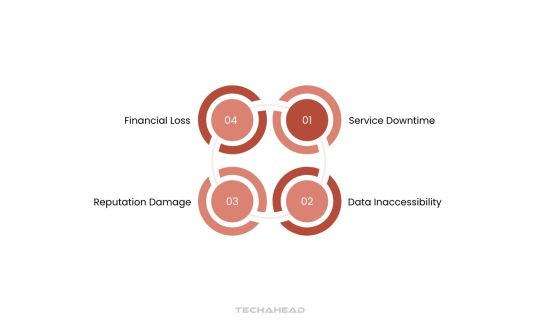
Cloud outages are periods when cloud-hosted applications and services become temporarily inaccessible. During these downtimes, users face slow response times, connectivity issues, or complete service disruptions. These interruptions can severely impact businesses across multiple dimensions.
The financial repercussions of cloud outages are immediate and far-reaching. When services go offline, organizations lose revenue as customers are unable to complete transactions. Additionally, businesses cannot track critical performance metrics, which can lead to operational inefficiencies and delayed decision-making.
Beyond monetary losses, cloud outages also cause reputational damage. Frustrated customers often perceive these disruptions as a sign of unreliability. A lack of transparent communication during downtime further exacerbates customer dissatisfaction. Over time, this can erode trust and push clients toward competitors offering more dependable solutions.
Another critical concern during cloud outages is the potential for legal consequences. If an outage leads to data loss, breaches, or compromised privacy, businesses may face litigation, regulatory penalties, and increased scrutiny. The fallout from such incidents can add both financial and reputational burdens.
Long-term consequences of cloud outages include reduced customer satisfaction, loss of client loyalty, and ongoing revenue declines. Organizations may also incur significant costs to restore affected systems and prevent future outages. Inadequate cloud infrastructure increases the risk of repeated disruptions, making businesses more vulnerable to prolonged downtimes.
To mitigate these risks, organizations must proactively invest in robust backup and recovery systems. Reliable disaster recovery plans and redundancies help minimize downtime, ensuring business continuity during unforeseen cloud outages. This strategic approach safeguards revenue streams, protects customer trust, and fortifies operational resilience.
Common Causes of Cloud Outages
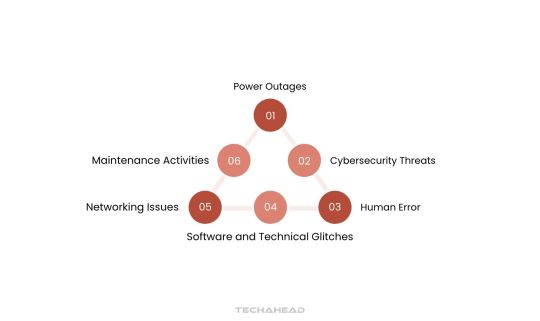
Cloud outages can stem from various factors, both within and beyond the control of cloud vendors. These challenges must be addressed to ensure cloud services meet Service Level Agreements (SLAs) with optimal performance and reliability.
Power Outages
Power disruptions are one of the most prevalent causes of cloud outages. Data centers operate on an enormous scale, consuming anywhere from tens to hundreds of megawatts of electricity. These facilities often rely on national power grids or third-party-operated power plants.
Consistently maintaining sufficient electricity supply becomes increasingly difficult as demand surges alongside market growth. Limited power scalability can leave cloud infrastructure vulnerable to sudden disruptions, impacting the availability of hosted services. To address this, cloud vendors invest heavily in backup solutions like on-site generators and alternative energy sources.
Cybersecurity Threats
Cyber attacks, such as Distributed Denial of Service (DDoS) attacks, overwhelm data centers with malicious traffic, disrupting legitimate access to cloud services. Despite robust security measures, attackers continuously identify loopholes to exploit. These intrusions may trigger automated protective mechanisms that mistakenly block legitimate users, leading to unexpected downtime.
In severe cases, breaches result in data leaks, service shutdowns, or prolonged outages. Cloud vendors constantly refine their defense systems to combat these evolving threats and ensure service continuity despite rising cybersecurity challenges.
Human Error
Human errors, though rare, can have catastrophic effects on cloud infrastructure. A single misconfiguration or incorrect command may trigger a chain reaction, causing widespread outages. Even leading cloud providers have experienced significant disruptions due to human oversight.
For instance, a human error at an AWS data center in 2017 led to widespread Internet outages globally. Although anomaly detection systems can identify such issues early, complete restoration often requires system-wide restarts, prolonging the recovery period. Cloud vendors mitigate this risk through rigorous protocols, automation tools, and comprehensive staff training.
Software and Technical Glitches
Cloud infrastructure relies on a complex interplay of hardware and software components. Even minor bugs or glitches within this ecosystem can trigger unexpected cloud outages. Technical faults may remain undetected during routine monitoring until they manifest as critical service disruptions. When these incidents occur, identifying and resolving the root cause can take time, leaving end-users unable to access essential services. Cloud vendors implement automated monitoring, rigorous testing, and proactive maintenance to identify vulnerabilities before they impact operations.
Networking Issues
Networking failures are other significant contributor to cloud outages. Cloud vendors often rely on telecommunications providers and government-operated networks for global connectivity. Issues in these external networks, such as damaged infrastructure or cross-border disruptions, are beyond the vendor’s direct control. To mitigate these risks, leading cloud providers operate data centers across geographically diverse regions. Dynamic workload balancing allows cloud vendors to shift operations to unaffected regions, ensuring uninterrupted service delivery even during network failures.
Maintenance Activities
Scheduled and unscheduled maintenance is essential for improving cloud infrastructure performance and cloud security. Cloud vendors routinely conduct upgrades, fixes, and system optimizations to enhance service delivery. However, these maintenance activities may require temporary service interruptions, workload transfers, or full system restarts.
During this period, end-users may experience service disruptions classified as cloud outages. Vendors strive to minimize downtime through well-planned maintenance windows, redundancy systems, and real-time communication with customers.
Global Cloud Outage Statistics and Notable Cases
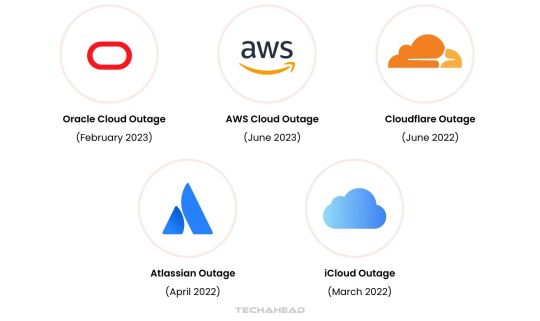
Cloud outages remain a critical challenge for organizations worldwide, often disrupting essential operations. Below are significant real-world examples and insights drawn from these incidents to uncover key lessons.
Oracle Cloud Outage (February 2023)
In February 2023, Oracle Cloud Infrastructure encountered a severe outage triggered by an erroneous DNS configuration update. This impacted Oracle’s Ashburn data center, causing widespread service interruptions. The outage affected Oracle’s internal systems and global customers, highlighting the importance of robust change management protocols in cloud operations.
AWS Cloud Outage (June 2023)
AWS faced an extensive service disruption in June 2023, affecting prominent services, including the New York Metropolitan Transportation Authority and the Boston Globe. The root cause was a subsystem failure managing AWS Lambda’s capacity, revealing the need for stronger subsystem reliability in serverless environments.
Cloudflare Outage (June 2022)
A network configuration change caused an unplanned outage at Cloudflare in June 2022. The incident lasted 90 minutes and disrupted major platforms like Discord, Shopify, and Peloton. This outage underscores the necessity for rigorous testing of configuration updates, especially in global networks.
Atlassian Outage (April 2022)
Atlassian suffered one of its most prolonged outages in April 2022, lasting up to two weeks for some users. The disruption was due to underlying cloud infrastructure problems compounded by ineffective communication. This case emphasizes the importance of clear communication strategies during extended outages.
iCloud Outage (March 2022)
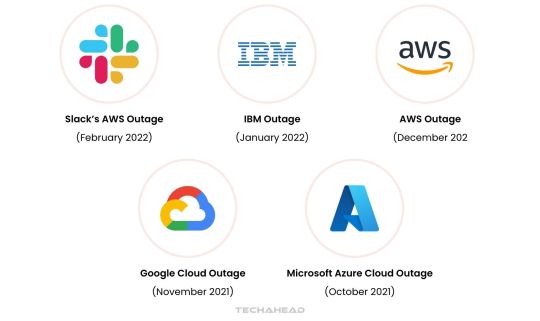
Slack’s AWS Outage (February 2022)
In February 2022, Slack users faced a five-hour disruption due to a configuration error in its AWS cloud infrastructure. Over 11,000 users experienced issues like message failures and file upload problems. The outage highlights the need for quick troubleshooting processes to minimize downtime.
IBM Outage (January 2022)
IBM encountered two significant outages in January 2022, the first lasting five hours in the Dallas region. A second, one-hour outage impacted virtual private cloud services globally due to a remediation misstep. These incidents highlight the importance of precision during issue resolution.
AWS Outage (December 2021)
AWS’s December 2021 outage disrupted key services, including API Gateway and EC2 instances, for nearly 11 hours. The issue stemmed from an automated error in the “us-east-1” region, causing network congestion akin to a DDoS attack. This underscores the necessity for robust automated system safeguards.
Google Cloud Outage (November 2021)
A two-hour outage impacted Google Cloud in November 2021, disrupting platforms like Spotify, Etsy, and Snapchat. The root cause was a load-balancing network configuration issue. This incident highlights the role of advanced network architecture in maintaining service availability.
Microsoft Azure Cloud Outage (October 2021)
Microsoft Azure experienced a six-hour service disruption in October 2021 due to a software issue during a VM architecture migration. Users faced difficulties deploying virtual machines and managing basic services. This case stresses the need for meticulous oversight during major architectural changes.
These examples serve as critical reminders of vulnerabilities in cloud systems. Businesses can minimize the impact of cloud outages through proactive measures like redundancy, real-time monitoring, and advanced disaster recovery planning.
Ways to Manage Cloud Outages
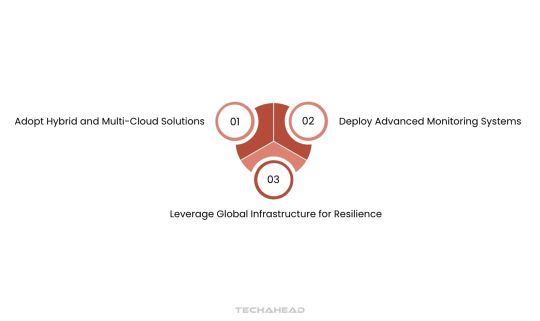
While natural disasters are unavoidable, strategic measures can help you mitigate and overcome cloud outages effectively.
Adopt Hybrid and Multi-Cloud Solutions
Redundancy is key to minimizing cloud outages. Relying on a single provider introduces a single point of failure, which can disrupt your operations. Implementing failover mechanisms ensures continuous service delivery during an outage.
Hybrid cloud solutions combine private and public cloud infrastructure. Critical workloads remain operational on the private cloud even when the public cloud fails. This approach not only safeguards core business functions but also ensures compliance with data regulations.
According to Cisco’s 2022 survey of 2,577 IT decision-makers, 73% of respondents utilized hybrid cloud for backup and disaster recovery. This demonstrates its effectiveness in reducing downtime risks.
Multi-cloud solutions utilize multiple public cloud providers simultaneously. By distributing workloads across diverse cloud platforms, businesses eliminate single points of failure. If one service provider experiences downtime, another provider ensures service continuity.
Deploy Advanced Monitoring Systems
Cloud outages do not always cause full system failures. They can manifest as delayed responses, missed queries, or slower performance. Such anomalies, if ignored, can impact user experience before they escalate into major outages.
Implementing cloud monitoring systems helps you proactively detect irregularities in performance. These tools identify early warning signs, allowing you to resolve potential disruptions before they affect end users. Real-time monitoring ensures seamless operations and reduces the risk of unplanned outages.
Leverage Global Infrastructure for Resilience
Natural disasters and regional disruptions are inevitable, but you can minimize their impact. Distributing IT infrastructure across multiple geographical locations provides a robust solution against localized cloud outages.
Instead of relying on a single data center, consider global redundancy strategies. Deploy backup systems in geographically diverse regions, such as U.S. Central, U.S. West, or European data centers. This ensures uninterrupted service delivery, even if one location goes offline.
For businesses operating in Europe, adopting multi-region solutions also supports GDPR compliance. This way, customer data remains protected, and operations continue seamlessly, regardless of cloud disruptions.
By leveraging global infrastructure, businesses can enhance reliability, improve redundancy, and build resilience against unforeseen cloud outages.
Additional Preventive Measures for Businesses
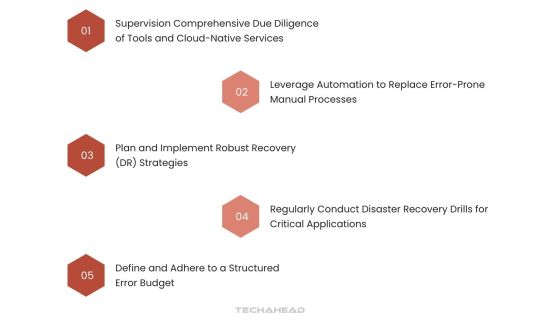
To effectively mitigate the risk of cloud outages, CIOs can adopt a multi-faceted approach that enhances resilience and ensures business continuity:
Supervision Comprehensive Due Diligence of Tools and Cloud-Native Services
Conduct a thorough evaluation of cloud-native services, ensuring they meet organizational requirements for scalability, security, and performance. This involves reviewing vendor capabilities, compatibility with existing infrastructure, and potential vulnerabilities that could lead to cloud outages. Regular audits help identify gaps early, preventing disruptions.
Leverage Automation to Replace Error-Prone Manual Processes
Automating operational tasks, such as provisioning, monitoring, and patch management, minimizes the human errors often linked to cloud outages. Automation tools also enhance efficiency by streamlining workflows, allowing IT teams to focus on proactive system improvements rather than reactive troubleshooting.
Plan and Implement Robust Recovery (DR) Strategies
A well-structured DR strategy is critical to quickly recover from cloud outages. This involves identifying mission-critical applications, determining acceptable recovery time objectives (RTOs), and creating recovery workflows. Comprehensive planning ensures minimal data loss and rapid resumption of services, even during large-scale disruptions.
Regularly Conduct Disaster Recovery Drills for Critical Applications
Testing DR plans through realistic drills allows organizations to simulate cloud outages and measure the effectiveness of their recovery protocols. These exercises reveal weaknesses in existing plans, providing actionable insights for improvement. Frequent testing also builds confidence in the system’s ability to handle unexpected disruptions.
Define and Adhere to a Structured Error Budget
An error budget establishes a clear threshold for acceptable service disruptions, balancing innovation and stability. It quantifies the permissible level of failure, enabling organizations to implement risk management frameworks effectively. This approach ensures proactive maintenance, minimizing the chances of severe cloud outages while allowing room for improvement.
By combining these preventive measures with ongoing monitoring and optimization, CIOs can significantly reduce the likelihood and impact of cloud outages, safeguarding critical operations and maintaining customer trust.
Conclusion
Although cloud outages are unavoidable when depending on cloud services, understanding their causes and consequences is crucial. Organizations can mitigate the risks of cloud outages by proactively adopting best practices that ensure operational resilience.
Key strategies include implementing redundancy to eliminate single points of failure, enabling continuous monitoring to detect issues early, and scheduling regular backups to safeguard critical data. Robust security measures are also essential to protect against vulnerabilities that could exacerbate outages.
In today’s cloud-reliant environment, being proactive is vital. Businesses that anticipate potential disruptions are better positioned to maintain seamless operations and customer trust. Proactive planning not only minimizes the operational impact of cloud outages but also reinforces long-term business continuity.
For better seamless cloud computing you should go for a proud partner like TechAhead. We can help you in migrating and consulting for your cloud environment.
Source URL: https://www.techaheadcorp.com/blog/understanding-cloud-outages-causes-consequences-and-mitigation-strategies/
0 notes
Text
How to Choose the Right Cloud Service Provider for Your Business
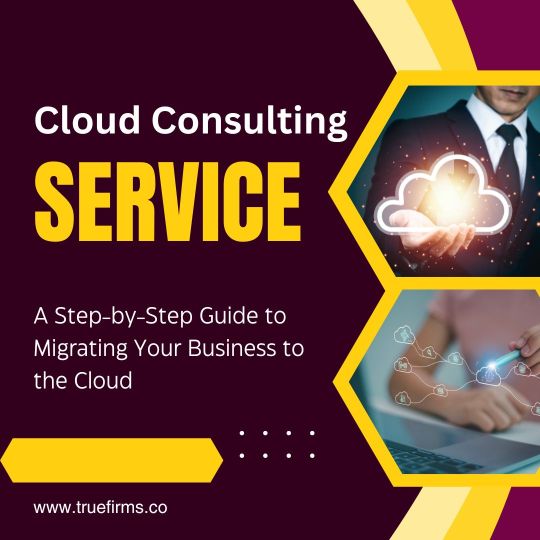
Selecting the right cloud service provider is one of the most critical decisions in your migration journey. This blog highlights the key factors to consider when evaluating providers like AWS, Microsoft Azure, and Google Cloud. Learn how pricing structures, features, scalability options, and security measures differ between providers. We also discuss compliance standards, SLAs, and customer support, helping you make an informed decision. A reliable cloud provider can ensure your migration is smooth, secure, and aligned with your long-term goals. Whether you’re new to cloud computing or looking to switch providers, this guide will simplify your decision-making process.
Read more:
A Step-by-Step Guide to Migrating Your Business to the Cloud
#cloud computing#cloud services#cloud security#cloudcloud infrastructure#cloud infrastructure#cloud infrastrasture#cloud migration
0 notes